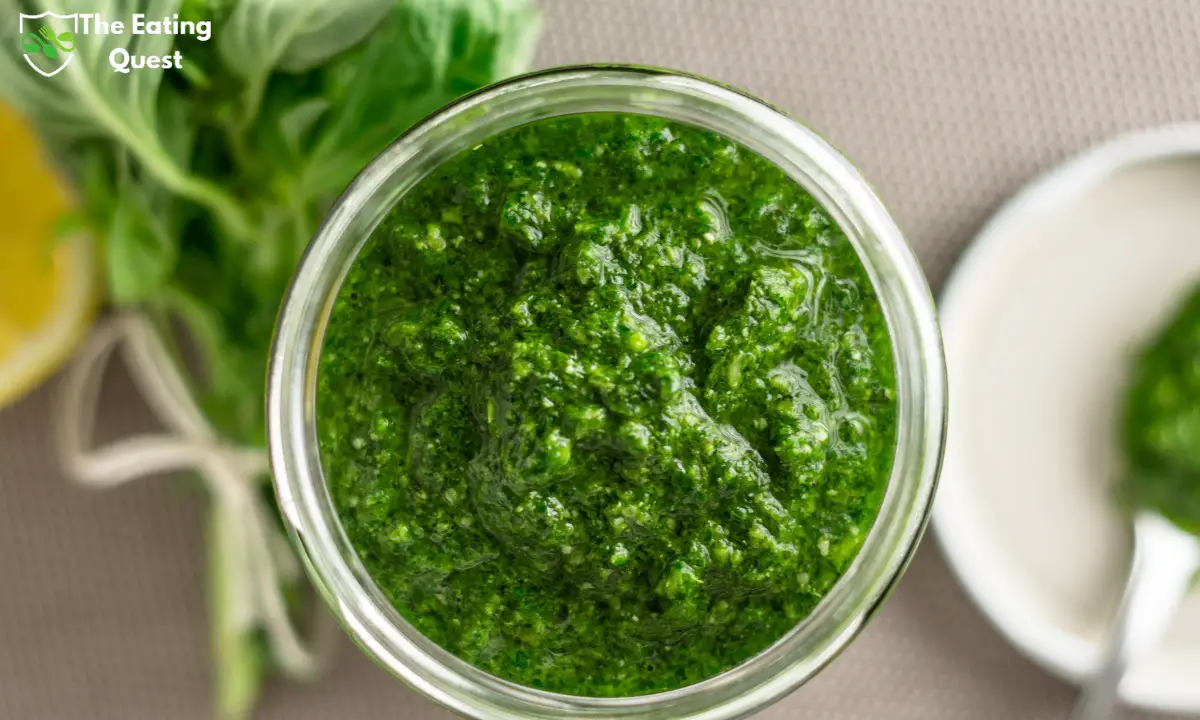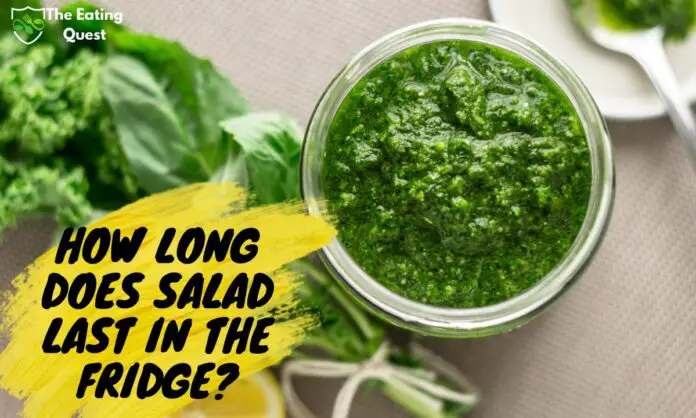lsoIf you’re a fan of pesto, you know how versatile it can be. From pasta to sandwiches to dips, pesto can add a burst of flavor to any dish. But what happens when you make too much or have leftovers? How long does pesto last in the fridge?
The answer to this question depends on a few factors. First, it’s important to note that homemade pesto will typically last for a shorter amount of time than store-bought pesto due to the lack of preservatives. Additionally, the ingredients used in the pesto can affect its shelf life. For example, pesto made with fresh herbs and cheese may spoil faster than pesto made with dried herbs and no cheese. Finally, the temperature and storage conditions of the pesto can impact its longevity.
So, how long can you expect your pesto to last in the fridge? Keep reading to find out.
How Long Does Pesto Last in the Fridge?
If you have made or bought pesto and are wondering how long it can last in the fridge, you’re not alone. Pesto is a delicious sauce made from fresh ingredients, but it can go bad quickly if not stored properly.
The shelf life of pesto can vary depending on the ingredients used, the storage conditions, and whether it contains any preservatives. Generally, homemade pesto can last up to 5-7 days in the fridge, while store-bought pesto can last up to 2 weeks after opening if properly stored.
To ensure that your pesto lasts as long as possible, make sure to store it in an airtight container in the fridge. It is also important to keep it away from any sources of heat or light, as this can cause the pesto to spoil more quickly.
If you’re not sure if your pesto is still good, look for any signs of spoilage such as a sour smell, mold, or discoloration. If you notice any of these signs, it’s best to discard the pesto to avoid the risk of food poisoning.
In summary, the shelf life of pesto can vary depending on several factors, but generally, homemade pesto can last up to 5-7 days in the fridge, while store-bought pesto can last up to 2 weeks after opening if properly stored. Make sure to store your pesto in an airtight container in the fridge and keep it away from heat and light to extend its shelf life.
How Long Does Pesto Pasta Last in the Fridge
If you have leftover pesto pasta, you may be wondering how long it will last in the fridge. The answer depends on several factors, including the ingredients in the pesto and how it was stored.
In general, homemade pesto pasta will last 3-5 days in the fridge. However, if you used fresh ingredients and stored it properly, it may last up to a week. If you’re unsure if your pesto pasta is still good to eat, check for any signs of spoilage, such as mold or a sour smell.
To extend the shelf life of your pesto pasta, store it in an airtight container in the fridge. You can also freeze pesto pasta for up to 3 months. When reheating frozen pesto pasta, be sure to thaw it in the fridge overnight and then heat it up in a pan on low heat.
It’s important to note that the shelf life of pesto pasta can vary depending on the type of pasta you used. For example, fresh pasta will spoil faster than dried pasta. Additionally, if you added any meat or dairy to your pesto pasta, it may spoil faster than a vegetarian version.
Overall, it’s best to consume your pesto pasta within a few days of making it to ensure it’s fresh and safe to eat.
How Long Does Fresh Pesto Last in the Fridge?
If you’ve made fresh pesto and are wondering how long it will last in the fridge, the answer is that it depends on various factors. Here are a few things to consider:
- Ingredients: The ingredients you use to make pesto can affect its shelf life. For example, if you use fresh herbs, they will spoil faster than dried herbs. Similarly, if you use fresh garlic, it may cause the pesto to spoil faster than if you use garlic powder.
- Storage: Proper storage is essential to extend the shelf life of fresh pesto. Store it in a clean, airtight container in the fridge. Make sure the container is sealed tightly to prevent air and moisture from getting in.
- Temperature: The temperature of your fridge can also affect the shelf life of pesto. Keep it at a temperature of 40°F or below to prevent bacterial growth.
Generally, fresh pesto will last in the fridge for about 5-7 days. However, this can vary depending on the factors mentioned above. It’s always a good idea to use your senses to determine if pesto has gone bad. If it looks or smells off, or if you see any mold, it’s best to throw it out.
To extend the shelf life of your pesto, you can also freeze it. Simply transfer it to a freezer-safe container and store it in the freezer for up to 6 months. When you’re ready to use it, thaw it in the fridge overnight.

How Long Does Jarred Pesto Last in the Fridge?
If you are a fan of pesto, you may have wondered how long it lasts in the fridge. Jarred pesto is a convenient option for those who don’t have the time or ingredients to make it from scratch. So, how long does jarred pesto last in the fridge?
The answer to that question depends on a few factors, such as the ingredients, preservatives, and storage conditions. Generally, jarred pesto can last up to 2 weeks in the fridge if it is stored properly.
To ensure that your jarred pesto lasts as long as possible, it is important to keep it in the fridge at all times. Make sure that the lid is tightly sealed after each use to prevent air from getting in. Exposure to air can cause the pesto to spoil faster.
Another tip to extend the shelf life of your jarred pesto is to store it in the coldest part of the fridge, such as the back or bottom shelf. This will help keep the temperature consistent and prevent the pesto from spoiling prematurely.
It’s also important to note that the expiration date on the jar is a good guideline to follow, but it’s not always accurate. The quality of the pesto may start to decline after the expiration date, but it may still be safe to eat for a few more days.
In summary, jarred pesto can last up to two weeks in the fridge if it is stored properly and kept in the coldest part of the fridge. Make sure to seal the lid tightly after each use and follow the expiration date on the jar as a guideline.
How to do Proper Storage of Pesto?
When it comes to storing pesto, proper storage is crucial to maintain its freshness and flavor. Here are some tips on how to store pesto properly:
Refrigeration
If you plan to use your pesto within a week, store it in an airtight container in the refrigerator. Here’s how to do it:
- Transfer the pesto into a clean, airtight jar or container.
- Press a sheet of plastic wrap directly onto the surface of the pesto to prevent air exposure.
- Seal the jar or container tightly and store it in the refrigerator.
Pesto can last up to a week in the refrigerator if stored properly. However, keep in mind that the flavor and texture may start to deteriorate after a few days.
Freezing
If you have leftover pesto or want to store it for longer, freezing is a great option. Here’s how to do it:
- Transfer the pesto into a clean, airtight jar or container.
- Press a sheet of plastic wrap directly onto the surface of the pesto to prevent air exposure.
- Seal the jar or container tightly and label it with the date.
- Place the container in the freezer.
Pesto can last up to 6 months in the freezer if stored properly. When you’re ready to use it, simply thaw it in the refrigerator overnight or at room temperature for a few hours.
Remember to always use clean utensils when handling pesto and avoid exposing it to air as much as possible. By following these tips, you can enjoy fresh and flavorful pesto for longer.
How to Tell if Pesto is Bad
Pesto is a delicious sauce made with fresh basil, garlic, nuts, cheese, and olive oil. It’s a versatile ingredient that can be used in many dishes, from pasta to sandwiches. However, like any food, pesto can go bad if it’s not stored properly or used within a certain time frame.
Here are some signs to look out for to tell if your pesto has gone bad:
- Mold: If you see any mold growing on the surface of your pesto, it’s time to throw it away. Mold can be dangerous to your health and can cause food poisoning.
- Off smell: If your pesto smells sour, rancid, or off in any way, it’s best to err on the side of caution and throw it away.
- Discoloration: If your pesto has turned brown or has any discoloration, it’s a sign that it’s gone bad. Fresh pesto should be bright green in color.
- Taste: If your pesto tastes bitter or has an off flavor, it’s best to discard it.
To make sure your pesto lasts as long as possible, store it in an airtight container in the refrigerator. It should last for about a week in the fridge, but it’s best to use it within three to five days. If you want to freeze your pesto, it can last for up to 6 months in the freezer.
In summary, it’s important to know how to tell if your pesto has gone bad to avoid any potential health risks. Keep an eye out for mold, off smells, discoloration, and off flavors, and always store your pesto properly to extend its shelf life.
The Role of Ingredients in Pesto’s Shelf Life
Pesto is a delicious and versatile sauce that can be used in a variety of dishes. However, like any food, it has a limited shelf life. The shelf life of pesto depends on a variety of factors, including the ingredients used to make it. In this section, we will explore the role that different ingredients play in pesto’s shelf life.
Basil
Basil is the star ingredient in pesto, and it is also the ingredient that has the shortest shelf life. Fresh basil leaves will only last a few days in the fridge before they start to wilt and turn brown. To extend the shelf life of your pesto, it is best to use fresh basil leaves as soon as possible. Alternatively, you can use dried basil, which has a longer shelf life.
Olive Oil
Olive oil is another important ingredient in pesto, and it plays a key role in extending the shelf life of the sauce. Also Olive oil has natural preservative properties that can help to keep your pesto fresh for longer. However, it is important to use high-quality olive oil, as lower quality oils may not have the same preservative properties.
Cheese
Cheese is a common ingredient in pesto, and it can also help to extend the shelf life of the sauce. Hard cheeses like Parmesan and Pecorino Romano have a longer shelf life than softer cheeses like mozzarella. If you are making pesto with softer cheeses, it is best to use the sauce within a few days.
Nuts
Nuts are another common ingredient in pesto, and they can help to give the sauce a nice texture and flavor. However, nuts can also go rancid quickly, which can affect the shelf life of your pesto. To extend the shelf life of your pesto, it is best to store it in an airtight container in the fridge.
Garlic
Garlic is a flavorful ingredient that can add a lot of depth to your pesto. However, it is also a potent ingredient that can go bad quickly. To extend the shelf life of your pesto, it is best to use fresh garlic cloves and store the sauce in an airtight container in the fridge.
In summary, the shelf life of pesto depends on a variety of factors, including the ingredients used to make it. Fresh basil, high-quality olive oil, hard cheeses, properly stored nuts, and fresh garlic cloves can all help to extend the shelf life of your pesto.
Can Spoiled Pesto Make You Sick?
It is possible for spoiled pesto to make you sick. Pesto is made with fresh ingredients such as basil, garlic, and olive oil. When these ingredients are not stored properly, they can spoil and cause foodborne illness.
The main culprit for spoilage in pesto is the olive oil. Olive oil can go rancid if not stored in a cool, dark place. Once olive oil becomes rancid, it can produce harmful compounds that can cause gastrointestinal distress.
Additionally, pesto can also harbor harmful bacteria such as Salmonella and E. coli if not stored properly. These bacteria can cause food poisoning if consumed.
To prevent getting sick from spoiled pesto, it is important to follow proper food safety guidelines. Store pesto in an airtight container in the refrigerator and use it within 3-5 days. If you notice any signs of spoilage such as mold or a foul odor, discard the pesto immediately.
In summary, spoiled pesto can make you sick due to the potential presence of harmful bacteria and rancid olive oil. To prevent foodborne illness, store pesto properly and discard any pesto that shows signs of spoilage.
Frequently Asked Questions
How long does jarred pesto last after expiration date?
Jarred pesto can last for a few weeks past its expiration date if it has been stored properly. However, it is always recommended to check for any signs of spoilage such as mold or an off smell before consuming.
How long does red pesto last once opened?
Red pesto can last for up to two weeks in the fridge once opened. It is important to store it in an airtight container to prevent it from drying out or absorbing any odors from other foods.
Can you freeze pesto?
Yes, pesto can be frozen for up to six months. It is best to freeze it in small portions in an airtight container or ice cube tray for easy portioning.
How long does pesto last in the fridge after opening?
Pesto can last for up to two weeks in the fridge after opening if stored properly in an airtight container. It is important to check for any signs of spoilage before consuming.
How long does an open jar of pesto last?
An open jar of pesto can last for up to two weeks in the fridge if stored properly in an airtight container. It is important to check for any signs of spoilage before consuming.
Can I eat pesto after 5 days?
It is not recommended to consume pesto after five days as it may have spoiled or developed harmful bacteria. It is important to always check for any signs of spoilage before consuming.
Also Read:
How Long Does Salad Last in the Fridge?
How Long Does Cooked Broccoli Last Out of the Fridge?
















